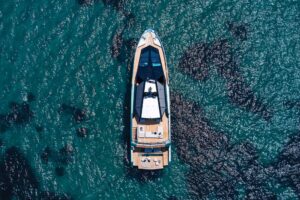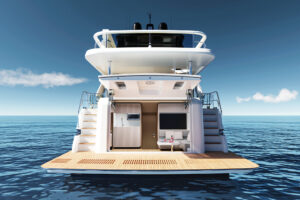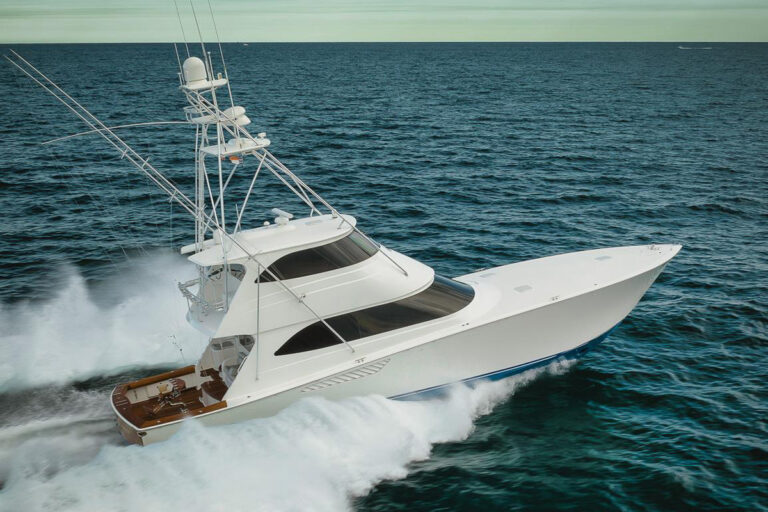The Fayerweather 60 is the E Class Mercedes of the waterways. She stands out in a crowd, showing subtle and tastefully executed design details and offering wonderfully quiet buttoned-down performance and handling.
I met the Fayerweather 60 Fayerweather on a velvety day in late February in Vero Beach, Florida, where she sunned herself in a slip at the Riomar Yacht Club. Her dark blue hull is a graphic way of spelling “Northeast yachting,” but it suits her the way the blue blazer has suited conservative yachtsmen for a century.
“This design was created for an experienced sailing couple moving into their first large powerboat,” said Penn Edmonds of Edmonds Design. The owners wanted to cruise comfortably at 25 knots in the typically messy sea state of Nantucket Sound. They also wanted extremely shoal draft, a generous pilothouse with good weather protection, and overnight accommodations for two couples.
The instant I set foot aboard the 60, I knew Edmonds and his partner, Oggie Pesek, had drawn her for just such a couple. Her maximum beam is only 11 feet, 5 inches, about 6 feet less than the current norm. Any sailor who has a foot in the rich tradition of yachting understands the value of length, having grown up on the silky motion of long, narrow yachts. If you want more space inside your new design, make it longer, not wider.
“This design combines a long, narrow hull form for efficiency and seakeeping with jet drives for shoal draft,” Edmonds said. The proportions also suited the arrangement criteria and yielded two private staterooms.
Dividing the accommodations into three areas creates the feel of a raised-saloon sailing yacht, only more inviting. The spaces are symmetrical, bright but cozy, and wonderfully useful. Guest quarters occupy the bow sections and share a head with the common area. Her narrow hull dictated an in-line galley, which is not ideal at sea, but is fine when the boat’s at anchor or under way at moderate speeds in light sea states.
Fayerweather’s owners use her as a committee boat and spectator platform during the summer sailboat racing season on Nantucket Sound. This use determined the spacious, open bridge deck amidships. The view from there is excellent, and opening windows and isinglass curtains aft provide all the ventilation anyone could want, especially in New England. A two-zone air-conditioning system cools the forward and after living areas.
Abaft the bridge deck is the owner’s stateroom. A hatch in the overhead and six portholes in the cabin trunk wash the area in natural light. A full-size companionway leads to the after cockpit. When the space is open, the stateroom feels like the screened-in porch of a beachside cottage. In deference to the narrow hull, the owner’s stateroom has a pair of single berths, one on each side smack against the after bulkhead. Each of these full-size singles is wide enough to cradle a pair of young lovers. The chest of drawers opposite would swallow all my clothing.
Driving Fayerweather is a tactile, emotional experience that’s hard to equal. Edmonds developed the hull shape to minimize vertical accelerations when the boat runs into the short, steep chop of Nantucket Sound. She feels as though she belongs in the water, moving quietly over and through it without making a huge disturbance. Her entry has a 50-degree deadrise and is very fine. She parts the water with a “pardon me, please,” and gets pushy only when she has to involve her forward chines. Even then, the increase in buoyancy sneaks up on the crew, rather than slapping them.
The rest of the bottom is a constant deadrise V-form of 19 degrees and is naked of lifting strakes. Her full-length sharp chines may fool you into thinking she rides on a planing bottom, but it’s more of a penetrating form. She does lift, but not much, keeping her center of gravity fairly low. She also doesn’t show a transition.
Oh my, is she ever quiet. Her Yanmars are far enough away from the helm to be in another ZIP code and are subdued by the “shushing” technology of SounDown. We conversed at normal volume while Fayerweather hustled along the ICW at her max of 33 knots. The hull, too, is quiet through the water.
Jet boats like to wander, and some require fins to make them track a straight line, but Fayerweather tracks well for a jet boat. The extraordinary maneuverability that jets provide at low speeds makes up for a bit of wandering. We were able to walk the 60 sideways, making only a tiny amount of way forward. If you drop the buckets to cover half the nozzles’ area, you can steer via the wheel in combination with quick bursts of throttle to turn sharply without moving too far forward. Turn on the autopilot, drop the buckets to half, and you can hold the bow to windward for as long as the fuel lasts.
In keeping with her antecedents, the Fayerweather 60’s dashboard is nearly horizontal, and her steering wheel is completely horizontal. The small-diameter Edson wheel was right at my chest level (I’m 5 feet, 6 inches tall). At first, this seemed far from ideal, but steering felt natural after 10 minutes. The boat’s owner specified unassisted steering, so it was heavier than I expected. I didn’t mind when we were cruising, but quick steering inputs were harder, therefore slower, than I like.
Goetz Boats laminated the entire boat with E-glass pre-preg vacuum-bagged over a balsa core and post-cured at 100 degrees Fahrenheit. Carbon fiber stiffens the longitudinals and house. After the hull has been faired and painted, another session of post-curing at about 150 degrees stabilizes the paint and fillers.
Narragansett Shipwrights of Newport, Rhode Island, did the joinery. The boat doesn’t have a liner, and she doesn’t need one. The Goetz crew faired and painted the back side of the laminate to a nearly perfect satin white.
Duplicating Fayerweather will require an investment of about $1.5 million. Like all great works of art, her value will grow, and her simple elegance will seem fresh for generations.
Contact: Edmonds Design, (617) 489-7731; fax (617) 489-7736; penn@edmondsdesign.com; www.edmondsdesign.com.









